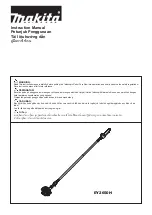
6
Emergency Preparedness
•
Keep a fi re extinguisher on your tractor and check the
expiration date periodically!
•
Keep a well stocked fi rst aid kit on your tractor.
•
Save In Case of Emergency ( I.C.E ) numbers on your cell phone
(including doctors, hospital and 911 services).
•
Keep I.C.E. numbers next to a home or offi ce phone.
Keep Riders off Machinery
•
Only allow the operator on the machine. Keep riders off!
•
Riders may obstruct the operator’s view resulting in the tractor being
operated in an unsafe manner.
•
Riders on the tractor or LSC Circular Saw may be struck by foreign
objects or thrown off the machine causing serious injury.
•
Never allow children to operate equipment.
Wear Protective Equipment
•
Protective clothing and equipment should be worn.
•
Wear clothing and equipment appropriate for the job.
Avoid loose fi tting clothing to avoid entanglement with moving parts.
•
Keep hands, feet, clothing, and long hair or anything worn that can be
caught away from power-driven parts.
•
Prolonged exposure to loud noise can cause hearing impairment or loss.
Wear suitable hearing protection such as earmuffs or earplugs.
•
Operating equipment requires the full attention of the operator.
•
Avoid wearing radio headphones, MP3 players or using cell phones
while operating equipment.
Transporting & Towing Loads Safely
•
Comply with state and local laws.
•
Maximum Travel speed for implement is 20 mph. DO NOT EXCEED!
•
Never travel at a speed which does not allow adequate control of
steering and stopping.
•
Sudden braking can cause a towed load to swerve and upset.
•
Reduce speed if towed load is not equipped with brakes.
•
IMPORTANT! Do not tow any load that is more than double the weight
of the tractor.
•
Stopping distance increases with speed and weight of the towed load.
Travel slowly and allow extra time and distance to stop.
•
Transport only with clean refl ectors, SMV signage and working lights.
•
Ensure that the implement components are in “up” or “Travel” position
before moving. Always remove LSC Circular Saw from vehicle before
transport.
•
Lower the implement to “fi eld position” when ready to use. This keeps
the load pulling below the center of gravity.
Avoid Tipping
•
Danger of tipping is increased greatly with tires are set in
narrow tread setting and driving at a high rate of speed.
•
LSC Circular Saw weight (based on model) plus 2505 pounds
of water weight (8.35 x 300 gallons) must not exceed combined
weight of tractor and operator. If the LSC Circular Saw + water
exceeds this weight then refer to the tractor’s manufacturer’s
recommendations for wheel weights or counterweights for added
stability when operating with LSC Circular Saw.
Use Caution Around Hydraulic Systems
•
Worn, lose or malfunctioning hydraulic hoses can cause
highly pressurized oil to escape, potentially causing great
harm to humans or equipment. Search for leaks with a piece of
cardboard. Protect hands and body from high pressure fl uids.
•
Keep Hydraulic hoses out of direct sunlight and in a controlled climate
during storage periods to prevent deterioration and increase hose life.
•
Avoid High-Pressure Fluids. Escaping fl uid under pressure can penetrate
the skin causing serious injury. Avoid the hazard by relieving pressure
before disconnecting hydraulic or other lines. Tighten all connections
before applying pressure.
Use Safety Lights and Devices
•
Slow moving tractors, self-propelled equipment, and towed
implements can create a hazard when driven on public
roads. They are diffi cult to see, especially at night.
•
Flashing WARNING lights and turn signals are recommended.
•
Use lights and devices provided with the machinery.
Tire & Wheel Safety
•
Read and understand any manufacturer’s warning contained in literature
or molded into the tire sidewall before servicing tires.
•
Only use specialized tools as recommended by tire
suppliers for mounting or dismounting tires.
•
Explosive separation of a tire and rim parts can
cause serious injury or death.
•
Do not attempt to remove a tire from the rim without
removing air pressure as this may cause serious
injury or death.
•
Check tires for low pressure, bulges (bubbles), cuts, damaged rims or
missing lug bolts and nuts.
•
Do not re-infl ate a tire that has been operated in a run-fl at or under
infl ated condition (80% or less than recommended pressure). Demount
and inspect tire and rim parts before re-infl ating.
Periodically, inspect the equipment’s tires:
•
Inspect inside of tire for loose cords, cuts, penetrating objects or other
casing damage.
•
Inspect valve cores. Replace valve cores if damaged or leaking.
•
Lubricate with only approved tire mounting lubricant or mild vegetable
oil soap solution. Do not use anti-freeze, silicones or petroleum base
lubricants as these will damage tires.
•
Un-repairable tires should be destroyed and replaced with tire having
the same rim diameter designation and suffi x letters.
•
Do not mount or use damaged tires or rims.
•
Check wheel hardware for tightness. Loose wheel nuts may cause
instability resulting in an accident that may result in serious injury.
Perform this check often during the fi rst 100 hours of operation.
•
Do not attempt to mount a tire without proper equipment or experience
in performing this operation.
•
Always maintain proper tire pressure. Do not over infl ate above the
recommended pressure. Low pressure may cause loss of control during
operation while on slopes or wet/slick surfaces.
SAFETY




































